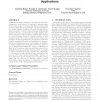Free Online Productivity Tools
i2Speak
i2Symbol
i2OCR
iTex2Img
iWeb2Print
iWeb2Shot
i2Type
iPdf2Split
iPdf2Merge
i2Bopomofo
i2Arabic
i2Style
i2Image
i2PDF
iLatex2Rtf
Sci2ools
107
click to vote
ISCA
2010
IEEE
2010
IEEE
Evolution of thread-level parallelism in desktop applications
As the effective limits of frequency and instruction level parallelism have been reached, the strategy of microprocessor vendors has changed to increase the number of processing cores on a single chip each generation. The implicit expectation is that software developers will write their applications with concurrency in mind to take advantage of this sudden change in direction. In this study we analyze whether software developers for laptop/desktop machines have followed the recent hardware trends by creating software for chip multi-processing. We conduct a study of a wide range of applications on Microsoft Windows 7 and Apple’s OS X Snow Leopard, measuring Thread Level Parallelism on a high performance workstation and a low power desktop. In addition, we explore graphics processing units (GPUs) and their impact on chip multi-processing. We compare our findings to a study done 10 years ago which concluded that a second core was sufficient to improve system responsiveness. Our resul...
Desktop Applications Permission | Hardware | ISCA 2010 | Software Developers | Thread Level Parallelism |
| Added | 28 Jan 2011 |
| Updated | 28 Jan 2011 |
| Type | Journal |
| Year | 2010 |
| Where | ISCA |
| Authors | Geoffrey Blake, Ronald G. Dreslinski, Trevor N. Mudge, Krisztián Flautner |
Comments (0)

